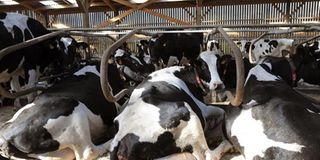Breaking News: At least 10 feared to have drowned in Makueni river
Silent disaster farmers ignore

Cows rest on mattresses, which help to make them comfortable. High-milk producing cows more exposed to fertility issues. PHOTO | FILE
What you need to know:
- A disease such as Leptospirosis (a bacterial disease spread through the urine of infected animals) has shattering effect on the number of your serviced cows that will conceive, high rates of abortion and possibly reduces production of the herd.
- Generally, a herd with great fertility is always close to its optimum production, thereby very profitable. Therefore, time spent in an attempt to deal with fertility issues on your farm is not wasted. Taking full control of your herd fertility also requires that you take action.
Many farmers judge the efficiency and profitability of their dairy animals by looking at the milk production, but place little emphasis on the herd’s fertility.
Put it differently. Many farmers would be worried of how fast a cow dries up than how long the same animal takes to get back on heat.
Poor fertility in the herd has remained an unnoticed disaster, yet it is the bridge to the most popular production goal, which is increased milk yield.
A less reproductive cow will take long to get into milk production since a calf has to be delivered for the animal to produce milk.
It is worth noting that high milk producing breeds such as Friesian and Ayrshire experience more fertility problems than the lower milk producing breeds like Guernsey and Jersey.
There is an antagonistic relationship between milk production and fertility, which leaves high-milk producing cows more exposed to fertility issues compared to low milk producers.
A heifer that does not conceive even after several inseminations has below optimum fertility.
A heifer’s fertility is determined by her age at first calving; how fast she gets back on heat after calving, the intervals between calving and reproductive disorders, among other factors.
The two key factors to watch are occurrences of diseases and feeding, as they have a direct influence on the fertility of dairy cows.
OPTIMUM PRODUCTION
A disease such as Leptospirosis (a bacterial disease spread through the urine of infected animals) has shattering effect on the number of your serviced cows that will conceive, high rates of abortion and possibly reduces production of the herd. In feeding, cows that lack energy or specific minerals hardly come to heat or show the signs, leading to mistiming of services hence increased number of inseminations and related costs.
If management is up to standard, then fertility will be of little or no challenge. Poor fertility, on the other hand, will lead to several losses:
There is loss of milk production characterised by longer dry periods.
Irregular calving and milk production means you earn less.
Calving may occur in a low feed season while a farm can experience several calvings when there is high milk supply in the market fetching lower prices.
Forced culling: Done after identifying an animal with several reproductive disorders.
Extra costs are incurred in veterinary services raising costs of production.
One ends up with few calves on the farm, which directly influences the replacement stock, costing the farm revenue that could be earned from possible calve sales.
One incurs additional servicing costs due to repeated number of inseminations from poor timing of service or silent heat.
Higher labour demand as poor reproductive efficient cows demand closer attention.
Desired genetic characteristics are also lost since the parents cannot pass the traits to the next generation.
Generally, a herd with great fertility is always close to its optimum production, thereby very profitable. Therefore, time spent in an attempt to deal with fertility issues on your farm is not wasted. Taking full control of your herd fertility also requires that you take action.
Regularly invite a veterinarian to inspect your herd with the aim of detecting fertility problems early enough and deal with it on time.
During feeding, ensure a balanced ration to avoid deficiencies of nutrients and minerals critical in reproduction. It is also proper that you monitor your animals keenly to detect heat at the right time to save costs on repeated inseminations. Keeping accurate breeding records too, is essential to monitor whether services successfully led to pregnancies or not, including the method and date of insemination.





